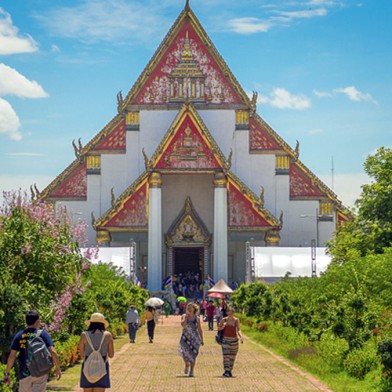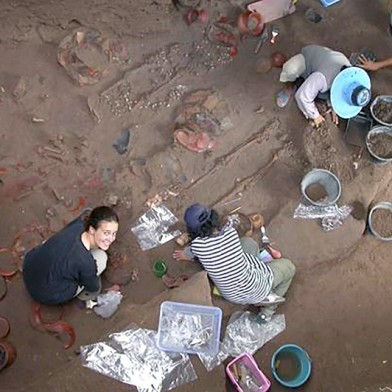New Zealander Laurence Wesley is the author of a textbook on soil mechanics that has become the profession’s “bible” in Indonesia – a country that regularly confronts killer landslips. Duncan Graham reports from East Java.
Anyone planning a hurried journey should avoid including a graduate from Dr Laurence Wesley’s class in the car.
They’d drag out the trip and annoy fellow passengers by demanding stops to inspect roadside cuttings. They’re excavation addicts, forever keen to peer beneath the topsoil.
“You can’t understand the science unless you go into the field and get a feel for the situation,” the New Zealand geotechnical engineer tells students in Indonesia.
“Technical results aren’t enough. We all like to play with nice programmes and show clients models; but please leave computers in the office and head for the site. Look around at the topography. What’s the soil made of – what’s its geological history? Use your common sense.”

Dr Laurence Wesley. (Photo: Erlinawati Graham)
Having dirt under the fingernails is considered proof of professionalism in the West. But there are constraints in countries that rank status above competence, according to Wesley – and that includes Indonesia.
In Indonesia, engineers are respected. The country's first president Soekarno studied civil engineering at the Bandung Institute of Technology, where he obtained an Ingenieur degree.
However for many, the title means earning the right to make others do the dirty work.
Wesley isn’t a foreign academic dumping alien habits onto another culture without understanding the subtleties. The retired University of Auckland lecturer is the author of Mekanika Tanah (Soil Mechanics), first published in 1972 by the Indonesian Public Works Ministry, and which is regularly reprinted.
It has been the profession’s bible in Indonesia and Malaysia for decades. Now the octogenarian has written a new Indonesian version which is also being published worldwide in English.
NZ and Indonesia share many characteristics that make engineers from the Shaky Isles welcome in the archipelago. Both countries feature in the Pacific Ocean Ring of Fire marking volcanic zones.
As a young man, Wesley wanted to use his degree to do good. He joined the now-defunct NZ Volunteer Graduate Scheme arriving in Indonesia in 1960 by boat. The first sight of the country that was to be “an important part of my life from that time through to the present” was the Sunda Strait island, Anak Krakatoa.
This is the "child" of the volcano which blew apart in 1883. Here was smoking proof of the power of nature in Java; reports of the explosion were heard 5,000 kilometres away in Central Australia. Thousands died in huge tsunamis.
Geotechnical engineers study the interface of nature and the endeavour of humans to impose their will on the world. How can steel and concrete bond with the soil so the dam doesn’t leak, the high-rise wobble and the highway crumble?
Ghastly accidents reinforce their responsibility. Mistakes can kill. Wesley has been an expert witness when trenches collapse and smother workers. The blame often lies with contractors cutting corners to cut costs.
It is long known that firm footings make for a safe structure. The Bible has a parable of the wise building on rock and the foolish on sand. It seems obvious. “Not so,” said Wesley. “Sand can be compressed and make a good base; not all rock is stable.”

Siti Romelah (right), caretaker of the 13th-century Hindu Kidal temple in East Java, discusses the andesite rocks used to build the place of worship. (Photo: Erlinawati Graham)
Science started replacing guesswork in the 1920s. When Wesley was sent to Bandung in the 1960s, he found Dutch-designed penetrometers (to measure underground soil compaction) in wide use. He had never encountered the machines in New Zealand.
But he did understand the value of equality in the workplace. He sought the technicians’ advice – behaviour alien to the Dutch-trained engineers. “It didn’t always make me popular,” he said.
The other problem was his bosses demanding precision when Wesley had already learned his profession was an inexact science. It still is.
“You can’t relate formula to the practical world,” he said. “Extreme rainfall, major floods and earthquakes make it impossible to avoid natural landslips, but we can measure soil composition and assign risk factors.”
With just stencilled notes to guide staff, the need for a textbook was pressing. Wesley learned Indonesian on the job and wrote the book examining sedimentary and residual soils – something other writers had ignored.
The textbook became a hit when published by the Indonesian Public Works Ministry, which in those days didn’t get fussed by having a foreigner’s name on the cover. Unfortunately, the author didn’t sign a contract so he missed out on royalties.
Wesley returned to New Zealand in 1962 to marry, and then returned with his teacher wife Barbara. Two of their children were born in Indonesia. Between 1963 and 1968 he worked for the NZ Ministry of Works before a further four-year stint in Indonesia under the Colombo Plan.
New Zealand and Indonesia share many characteristics that make engineers from the Shaky Isles welcome in the archipelago. Both countries feature in the Pacific Ocean Ring of Fire marking volcanic zones.
At a seminar in Malang (East Java) State University in August to promote his new book, participants asked Wesley: "If the science is so smart, why are new roads potholing and house walls cracking?"
Wesley blamed corrupt contractors using dodgy materials and failing to follow specifications.
“Quality control is essential – and that’s another reason to get out of the office and look at the site,” he said. “There’s a need in Indonesia for regulations requiring engineers’ reports on foundations as we do in New Zealand.
“Just having laws is not enough. They need to be enforced.”
- Asia Media Centre



